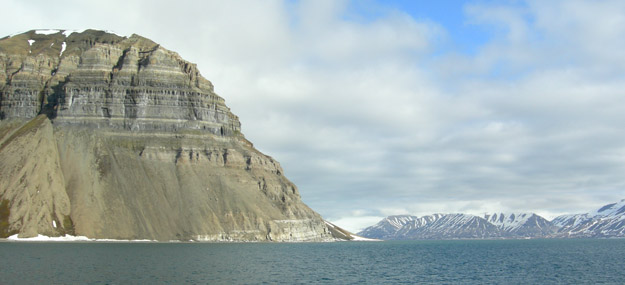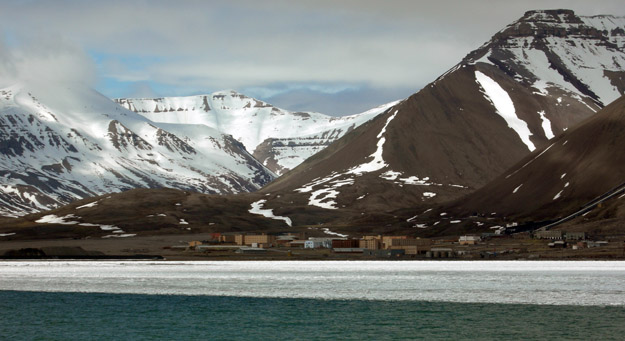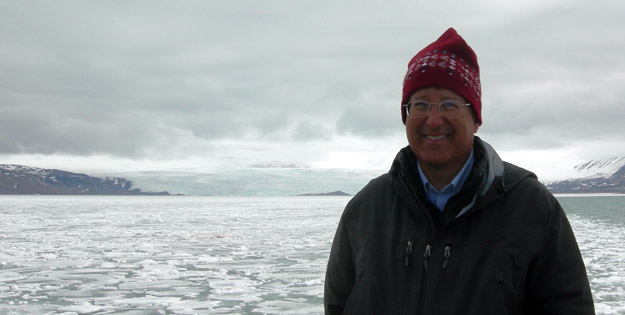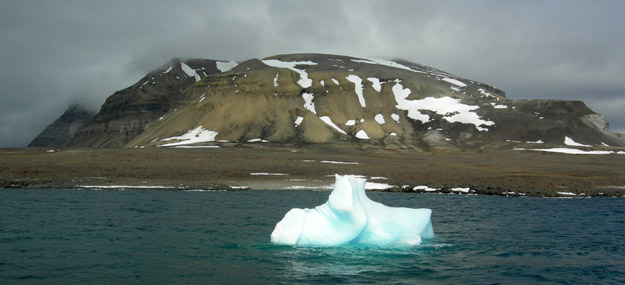Today I took a day trip with about 25 other people on the small ship M.S. Polargirl in Isfjorden. The geology in view was fantastic, it didn’t rain, and the sun came out occasionally in the morning. I also got to answer numerous questions about geology from my fellow passengers, which I enjoyed. This little trip also gave me more information about the stratigraphy and interesting geological issues which future Wooster students may be able to address.
There are many abandoned mines along the shores of the fjords. Most are easy to spot because the mine developers wanted to be able to transfer their products directly to ships from the shore. Two types were visible on this trip: gypsum mines and coal mines.

Abandoned gypsum mine at Skansen. The gypsum and anhydrite units are visible as white units at the base of the mountain on the right. The mine is on the left almost completely covered by talus and snow. The mine was abandoned soon after it was started in the 1920s because there was more anhydrite than gypsum in the units.

This is the abandoned Russian coal-mining town of Pyramiden. We were unable to land there because of the thick pack ice between us and the harbor. The town was evacuated quickly in 1998 as it became evident it could not survive economically without the subsidies it had received from the Soviet Union. I wanted to see its "northernmost statue of Lenin".
The very steep mountainsides on the edge of the fjords have developed spectacular talus cones dropping down into the sea.

Talus cones along the margin of Tempelfjord. Two cones were modified by the glacier now confined to the adjacent fjord.
We also saw three glaciers nosing into their fjords. One is still calving off icebergs.

With the Nordenskiold Glacier in the background, along with pack ice, this is as far as I can tell the northernmost Wooster geologist on June 27, 2009 (at N78.64044°, E16.43892°). He certainly is the coldest Wooster geologist on this date.
Two short clips: the ship moving into pack ice outside Pyramiden, and waves lapping onto an iceberg in Isfjorden.




You look cold!
Pingback: Paleoecology; The Kingdom of the Single-Celled Eucaryotes (September 6 & 8) | Invertebrate Paleontology at Wooster
Pingback: Paleoecology; The Kingdom of the Single-Celled Eucaryotes (Protista) (September 4 & 6) | Invertebrate Paleontology at Wooster
Pingback: Paleoecology; Protista: The Kingdom of the Single-Celled Eucaryotes (September 3 & 5) | Invertebrate Paleontology at Wooster
Pingback: Paleoecology; The Kingdom of the Single-Celled Eucaryotes (Protista) (August 26 & 28) | Invertebrate Paleontology at Wooster
Pingback: Paleoecology; The Kingdom of the Single-Celled Eucaryotes (September 1 & 3) | Invertebrate Paleontology at Wooster